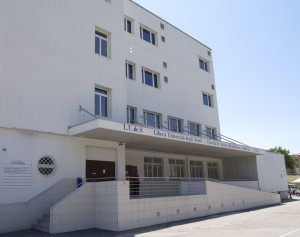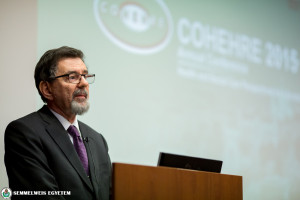Semmelweis University was the host of the 10th Hungarian National and International Lifelong Learning Conference organised by the MELLearN Higher Education Network. The aim of the event – entitled “Challenges and Possibilities in Higher Education” – was primarily to present the regional possibilities of innovation, to discuss the current European trends and to help higher educational institutions to familiarise themselves with the EU’s Horizon 2020 programme – from the perspective of the Swedish successes.
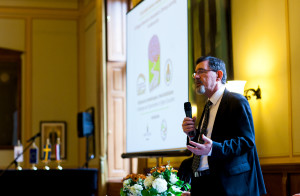 The future of higher education and adult learning lies in cross-border education and the application of innovative possibilities – said Dr. Ágoston Szél, rector of Semmelweis University in his welcome speech. “Not a day without a line drawn” – the Rector quoted the Greek painter Apelles through the words of Plinius. The idea that we should do something every day, either teaching or studying, could be the motto of lifelong learning as well. The Rector implied that the Association could have an important role in raising awareness at universities about the importance of lifelong learning and to promote its use in daily practice.
The future of higher education and adult learning lies in cross-border education and the application of innovative possibilities – said Dr. Ágoston Szél, rector of Semmelweis University in his welcome speech. “Not a day without a line drawn” – the Rector quoted the Greek painter Apelles through the words of Plinius. The idea that we should do something every day, either teaching or studying, could be the motto of lifelong learning as well. The Rector implied that the Association could have an important role in raising awareness at universities about the importance of lifelong learning and to promote its use in daily practice.
Dr. Gábor Szabó, president of the MELLearN Association and rector of the University of Szeged said that Hungary still has to improve in the field of lifelong learning but it also has perspectives. He pointed out that “the Finnish and Swedish partners have always been important in innovation and lifelong learning, and they provide good examples to follow”. According to him the quality of lifelong learning in a country can be a strong economic factor and it can be a point of consideration for international corporations whether or not to settle in Hungary.
The successes and challenges of the Swedish innovation were presented by Karin Olofsdotter, ambassador of the Kingdom of Sweden to Hungary.
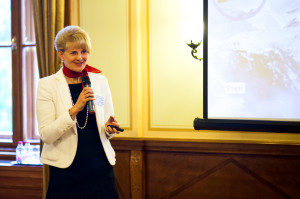 Semmelweis University’s activities and international education programmes were introduced by Dr. Mária Judit Molnár, vice-rector for scientific affairs. She emphasised that increasing the availability of cross-border education, developing open online courses and independent study methods are major strategic trajectories for the University. According to her online courses, study materials and the use of social media are currently the trends in higher education.
Semmelweis University’s activities and international education programmes were introduced by Dr. Mária Judit Molnár, vice-rector for scientific affairs. She emphasised that increasing the availability of cross-border education, developing open online courses and independent study methods are major strategic trajectories for the University. According to her online courses, study materials and the use of social media are currently the trends in higher education.
Apart from the fact that almost 3000 international students pursue their studies in English and German languages at Semmelweis University, it also has a number of accredited courses abroad, such as in Hamburg (Asklepios), in Lugano (L.U.de.S.), in Finland and the US (in the framework of the Atlantis programme) and in Slovakia (joint MSc with the Health Management Academy). The Chinese Heliongjiang Medical University’s traditional Chinese medicine programme at Faculty of Health Sciences is also one of the University’s many international programmes.
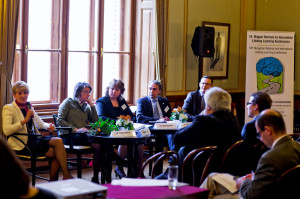 The main objective is cross-border mobility since the globalisation increases the possibilities of education through the so-called Massive Open Online Courses (MOOCs). Semmelweis University’s online course called “Webicina – social media in medicine” is available from all around the world and it is taught in English by Dr. Bertalan Meskó, medical futurist. Not only students can register for the course, but anyone who wishes to engage in lifelong learning.
The main objective is cross-border mobility since the globalisation increases the possibilities of education through the so-called Massive Open Online Courses (MOOCs). Semmelweis University’s online course called “Webicina – social media in medicine” is available from all around the world and it is taught in English by Dr. Bertalan Meskó, medical futurist. Not only students can register for the course, but anyone who wishes to engage in lifelong learning.
On the other hand, however, one of the University’s other online courses – “Disruptive Medical Technologies” – is only available for medical students. The course focuses on the most modern medical technologies and it is taught in cooperation with the University of Alberta in Canada relying on the use of social media.
[pullquote]more and more online courses are available at the University’s six faculties in Hungarian, English and German[/pullquote]E-learning also gains increasing influence in the SE curriculum and more and more online courses are available at the University’s six faculties in Hungarian, English and German as well. Through E-Learning, there are also new possibilities to develop joint courses with partner universities abroad (for example PhD students exchange).
The MELLearN Higher Education Network was established in 2002 and it initiates and coordinates public education, research and other scientific activities. Currently 18 Hungarian higher educational institutions are members of the Association. The general assembly took place right after the conference where – according to tradition – the new president’s inauguration was initiated. Dr. Ágoston Szél, rector of Semmelweis University and current board member of the Association will occupy the position of president during the next one year.
Pálma Dobozi
Translated by Bonifac Makkai
Photos: Attila Kovács, Semmelweis University
